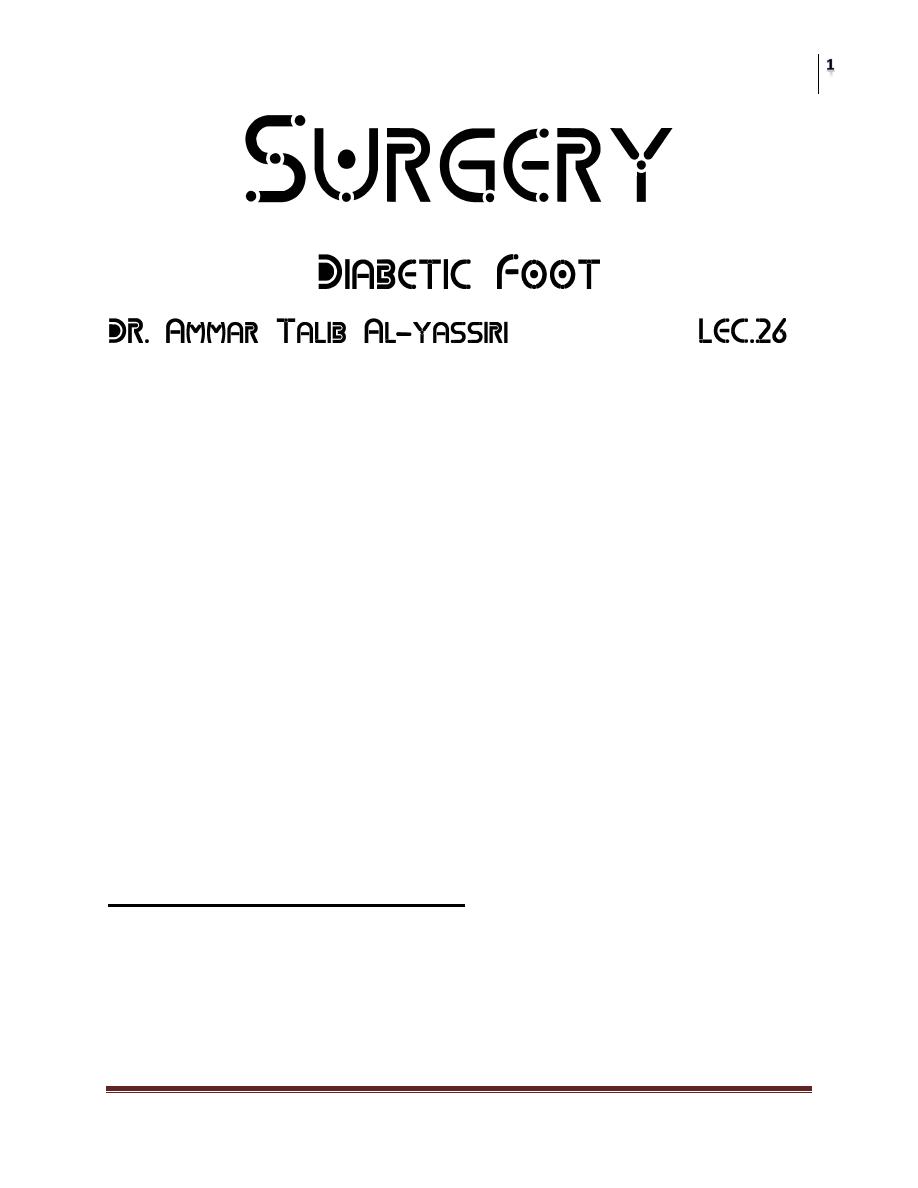
Surgery
Diabetic Foot
Dr. Ammar Talib Al-Yassiri
Lec. 26
The complications of longstanding diabetes mellitus often appear in the foot,
causing chronic disability.
Epidemiology:
More than 30% of patient attending diabetic clinics have evidence of
peripheral neuropathy or vascular disease
About 40% of non-trauma related amputations are for complications of
diabetes.
nearly one in six patients die within 1 year of their infection
Pathophysiology
Factors predisposing diabetic patients to developing diabetic foot are:
1. Peripheral vascular disease
2. damage to the peripheral nerves
3. Reduced resistance to infection
4. Osteoporosis
Peripheral vascular disease
Atherosclerosis affects mainly the medium sized vessels below the knee
Claudication or ischemic changes and ulceration in the foot.
The skin feels smooth and cold the nails show trophic changes .
Pulses are weak or absent
Superficial ulceration occurs on the toes

Surgery
Diabetic Foot
Dr. Ammar Talib Al-Yassiri
Lec. 26
Deep ulceration typically under the heel
Digital vessels occlusion may cause dry gangrene of one or more toes.
Proximal vascular occlusion resulting in extensive wet gangrene.
Peripheral neuropathy:
Early on the pt usually unaware of the abnormality but clinical tests will discover
loss of vibration and position sense and diminish of temperature discrimination in
the feet
Symptoms: mainly due to
1. sensory impairment: symmetrical numbness and parasthesia, dryness and
blistering of the skin, superficial burns and skin due to shoe scuffing or
localized pressure
2. Motor loss: muscle weakness and intrinsic muscle imbalance usually
manifests as claw toes with high arches and this may in turn predispose to
plantar ulceration.
Neuropathic joint disease (Charcot joints)
the mid tarsal joints are most commonly affected followed by the MTP and
ankle joints
There is usually provocative incident such as a twisting injury or a fracture
following which joint collapses relatively painlessly
In late cases there may be severe deformity and loss of function. A rocker-
bottom deformity from collapse of mid foot is diagnostic.
Osteoporosis
There is generalized loss of bone density in diabetes.
In the foot the changes may be severe enough to result in insufficiency fractures
around the ankles and or in the metatarsals.

Surgery
Diabetic Foot
Dr. Ammar Talib Al-Yassiri
Lec. 26
Infections
Diabetes, if not controlled is known to have adverse effect on the white cell
function. This combined with the local ischemia, insensitivity to skin injury and
localized pressure due to deformity, makes sepsis an ever recurring hazard.
Classification
Diabetic foot infection may be classified as:
- Superficial: often associated with ulceration.
- Deep infection: may involve soft tissues only with abscess formation or can
involve bones (osteitis or osteomylitis). This type of infection can also involve
local joints (pyogenic arithritis).
Another classification system is Wagner’s classification which is one of the
most widely used and universally accepted grading systems for
DFU,consisting of six simplistic wound grades used to assess ulcer depth
(grades 0-5)
Wagner classification system
0 Pre-ulcerative areas without open lesion
1 Superficial ulcer (partial/full thickness)
2 Ulcer deep to tendon, capsule, bone
3 Stage 2 with abscess, osteomyelitis or joint sepsis
4 Localized gangrene
5 Global foot gangrene.
